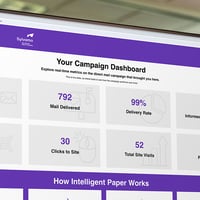3 Applications Where Print Actually Has the Edge Over Digital

A recent survey of more than 1,000 office workers found that 87% of participants spent an average of seven hours per day looking at a screen, and more than half of those surveyed reported some level of fatigue as a result of digital overload. For designers and marketers, this presents an interesting opportunity to use print as a reprieve from the digital deluge, but the challenge is identifying the right application where print can wield more power in creating an engaging, informative experience.
The good news is we have three specific instances where print actually has the edge over digital channels and the reasons why these applications are best suited for print. Let’s take a quick look at these three applications to help you understand how and why print still matters in an era where many people would have you believe digital channels are king.
Direct mail vs. email
There are some significant benefits with email marketing campaigns — they are usually faster to create, generate detailed reporting on performance and provide a wealth of opportunities for engagement via integrations like video or external links to related content. But even without all these bells and whistles, direct mail campaigns still offer just as much value to marketers because of how receptive audiences are to direct mailers.
In fact, here are a couple of pretty eye-opening statistics about the effectiveness of direct mail marketing, and the value today’s consumer still puts in quality direct mail campaigns:
- Up to 90% of direct mail pieces get opened
- 42% of direct mail gets read immediately upon delivery
- 75% of millennials report receiving direct mail makes them feel special
- 79% of consumers are more apt to respond to a print call-to-action compared with just 45% with email CTAs
- 82% of people trust print advertising more than any other communication channel, including email
The average person sends or receives about 120 emails per work day. Direct mail is not only a way to cut through the noise of this crowded digital communication channel, but it also opens up a lane to put more thought, time and value into your direct mailer in order to take advantage of an already receptive audience.
This is where personalization in direct mail can be extremely effective via highly targeted, variable content that uses customer data, purchasing history, lifecycle stage and more to address specific customer challenges and offer unique, tailored content and opportunities.
Paper menus vs. QR codes
The hospitality industry has shifted toward QR code menus in the last few years because they were thought to be more sanitary, easier to change or update and more cost-effective compared with multi-use plastic menus. However, paper menus have emerged as a more flexible and user-friendly option for the restaurant and customer alike.
First, paper menus help eventize the dining experience and add a unique, personal touch to the act of dining out. Paper menus — especially those that use premium paper stock and eye-catching finishings — can go a long way in making the dining experience feel special and unique again. The need to reach for a smartphone immediately after being seated to scan the code can detract from the dining experience, particularly for those looking to detach or disconnect from the digital world when dining out.
Plus, from a design standpoint, paper menus that incorporate interactive design elements or visual cues can delight and engage customers, and function as a creative way to cement or extend a restaurant’s branding.
For smaller restaurants that lack the staff or technical expertise to facilitate QR code technology — the code itself, a landing or website page or an online ordering system — paper menus are a more budget conscious and easier to implement option as they can be printed quickly and on an as-needed basis to reflect menu changes or item availability.
And paper menus free up restaurant owners or general managers from having to worry about things like web development, software upgrades, privacy concerns or network connectivity issues customers may experience with digital, QR code menus.
Reading in print vs. reading on digital devices
The case for reading on tablets or smartphones is that these digital devices are small, can store a lot of titles and information and make it easy for users to read just about anything wherever they are and whenever they want. But the verdict on whether people actually read better on these devices is still very much out — and, in fact, some of the data points to the fact users actually read poorly on digital platforms compared to reading in print.
While it may sound insignificant, the trouble with digital reading starts with scrolling. The ability to scroll increases the pace of reading, which can have a detrimental effect on comprehension and retention. Reading in a traditional paper context helps your brain understand, dissect and make connections with more complex information, and it promotes a better understanding of what you’re reading.
Plus, reading in print is easier on the eyes and makes you less prone to visual fatigue, which is a condition commonly associated with prolonged digital reading where your eye muscles tighten and often produce headaches or even blurred vision.
Even with technological advances in how digital screens are backlit or the accessibility preferences or settings of tablets or e-readers, a recent study revealed that visual fatigue when reading on a LCD screen was significantly higher and occurred much more quickly compared with reading via a print textbook.
What’s more, reading in print might actually be beneficial to your health as a study found the use of electronic devices like tablets or e-readers can have negative effects on your sleep cycles, specifically the amount of time it takes to fall asleep, and how long you stay in the REM sleep stage, which in part helps your body rest and recharge.
Ready to use your newfound paper knowledge? Both Accent Opaque Cover and Accent Opaque Text are 97 brightness to help you unlock next-level quality print.





